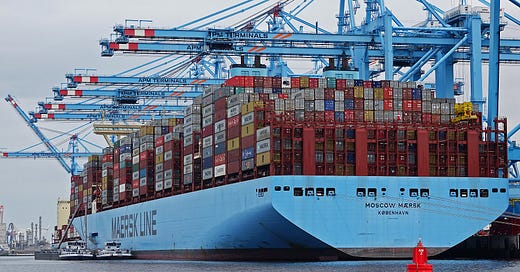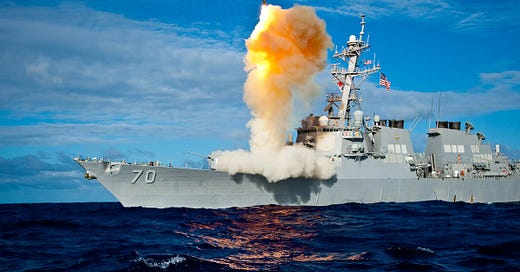

Discover more from Weapons and Strategy
Tass, the Russian State news service, says that an attempt by Ukraine to blow up the Kerch Strait bridge to Crimea was prevented when the Russians blew up a Ukrainian sea drone.
According to news reports, the Ukrainians tried three times to hit the famous bridge on September 1st.
The Russians have created a sea barrier of sunken ships to protect the bridge from sea attacks. These obstacles channel any attacking vessel and give the Russian an opportunity to interdict them and destroy them.
But there is more to the story than what is in Tass.
According to a report on the Military Channel, the Ukrainian attempt to destroy the bridge was aided and abetted by US overhead assets coordinating the Ukrainian operation.
The US fielded a Global Hawk Forte II (RQ-48) which is equipped with sophisticated sensors; a US Navy P-8A Poseidon (to track Russian ships and submarines); an Army CL-60 Artemis (Airborne Reconnaissance and Targeting Multi-Mission Intelligence System) and a Navy EP-3E Aries II, a multi-intelligence platform based on the venerable P-3. These platforms were intended to support the Ukrainian attempt to probe vulnerabilities in Russia's defenses adjacent to and on the bridge while also supporting the Ukrainian counter-offensive in southern Ukraine.
The Russians, at least so far, have said nothing other than they repulsed the attacks on the bridge.
The Kerch Strait bridge connects the Russian mainland to Crimea. It features a roadway and also supports the transit of freight trains. It is a vital roadway for Russian military operations in Crimea, Kherson and Zaphorize. The bridge is important enough that, after it was seriously damaged by a Ukrainian truck bomb attack, and repaired, Vladimir Putin himself drove a Mercedes car across the bridge.
Like the Nordstream pipeline, the US has made no secret of its desire to destroy the bridge. Whether the bridge can survive is anyone's guess. especially when the US is pouring significant efforts into its destruction.
The overall situation in the Kherson and Zaphorize regions, the focus of the main thrust of Ukraine's counter offensive, appears to show that Ukraine will not succeed in its declared objectives to breach Russia's defenses and re-take Melitopol. Meanwhile the Ukrainians have lost significant amounts of armor and incurred heavy casualties. Not only have these losses taken a toll, but many of Ukraine's best units have been chewed up.
Washington's best hope is to try and stabilize the front and bring the intense fighting to a halt, buying time for Ukraine to mobilize new forces, train them, and reequip their troops. That enterprise would take six months to a year if it happens. The plan, if it can be called that, is so far based on Russian reluctance to commit the bulk of its forces into an offensive to break the Ukrainian army. While there has been talk about Russia launching a big operation in the Kupyansk area, it has so far not materialized. Some suggest that Russia is waiting for Ukrainian forces to be reduced even further than they are already, before Russia's generals are willing to risk a true offensive.
The problem for the Russian side is that if they wait too long they will have to repeat everything again and take losses that the Russian public might not be willing to accept. There is a lot of talk in Moscow and on social media, some by serious politicians, that Russia should nuke Ukraine and go home. Others say that Russia should attack the supply depots in Germany and Poland and elsewhere, to in effect strangle the Ukrainian army. None of these proposals have gained much traction, but that could change if the war is drawn out. Oddly, Ukrainian attacks using drones and sabotage of installations on Russian territory may backfire on Ukraine by creating significant public anger in Russia that will require strong action by the government.
The potential for new troubles has been aided and abetted by an interview with Ukraine's chief of military intelligence Kyrylo Budanov who says that Ukraine should take the war to Russian territory. This would mean using its main army forces to attack across Russia's border (not just fire artillery shells, send in swat teams, or carry out arson, drone attacks and assassinations). His interview, if it is taken seriously, could have unintended consequences for Ukraine by stepping up the overall Russian response beyond the alleged limits of the Special Military Operation. For example, that could mean massive attacks on Kiev, or Odessa, or other actions designed to cripple Ukraine and its government.
Budanov makes many claims and a good many of them have to be taken with a grain of salt. However, we don't know which ones the Russians will take seriously.
Meanwhile, Washington continues to take big risks, starting with the supply of cluster munitions and, now, depleted uranium anti-tank shells. The use of US intelligence assets to target Russia is also a risk that could lead to a bigger conflict in Europe. If the Washington escalation continues it is hard to predict what will happen in the weeks ahead.
















i can see russia taking out the Global Hawk Forte II (RQ-48) and P-8A Poseidon... i don't think usa has a leg to stand on here.. they can complain, but they are complicit in the terrorist actions of the rogue state of ukraIne.. in fact, the usa and friends are now responsible for it.. it's coming, because nato and friends really aren't all that coy or cunning...
Yes, they're certainly keeping the intel aviation assets busy in the Black Sea area the last couple of weeks. As I'm typing, a P-8A is heading back to Sigonella where it seems to have been recently stationed. Two Global Hawks are rotated out of that airfield, too. Since Erdogan seems to be "back in the fold" now, NATO is once again utilizing Turkiye airspace; there were 2 E-3A Sentry planes there yesterday along the Black Sea coast, with the assortment of P-8A, GH, etc., over Constanta & the Black Sea. (and who knows what is in the air which isn't using its transponder) So the Black Sea coastline is almost encircled. The lack of activity over Turkiye could have been due to the earthquake, but the timing is interesting.
Here is the drone I've seen almost constantly over the coastline in Estonia & they pop up along the North Sea coastline sometimes too. Usually they don't have any good info when you click them, but one did a couple of days ago. For anyone who is interested:
https://www.textronsystems.com/products/aerosonde